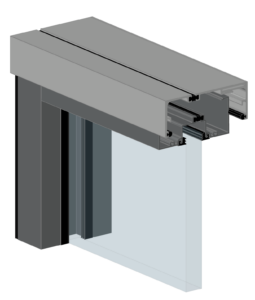Rethinking Storefront Glazing: Maximizing Durability with Head Receptors | LearnGlazing.com
Introduction
In the fast-paced world of architectural design and construction, we’re always looking for ways to make our storefront glazing systems better. And let’s be honest, one hero in this quest, often unsung, is the head receptor. These handy components are all about adapting to the ebb and flow of buildings, making sure our glazing systems stay strong and effective for years.
It’s interesting how, traditionally, head receptors popped up mainly when the blueprints called for them, or when installation quirks demanded their presence. But times are changing. More and more, the folks who make these systems and those who engineer them are singing the same tune: head receptors aren’t just an option; they’re becoming a must-have, and it’s about time we all start thinking about them right from the get-go.
Remember the days when we’d sort of shrug off how the top of a storefront system might handle a building’s little movements? Well, those days are behind us. We’ve seen the aftermath—systems under stress, leaks making unwanted appearances—largely because those systems were snug as a bug at the head and sill, with no room to breathe.
Benefits of Bringing Head Receptors into the Mix
Let’s dive into why head receptors are becoming the MVPs of storefront glazing:
- Sealing Reliability: These little wonders are all about giving the system some wiggle room, cutting down on how often we need to reseal and keeping everything structurally sound.
- Efficiency in Installation: They make installation a breeze, saving time and headaches, especially when the clock’s ticking on big projects.
- Handling Movements Like a Pro: Whether it’s the building settling in or the temperatures doing a number on the materials, head receptors keep things flexible, preventing any undue strain or damage. And we’re going to talk more about this because, let’s face it, traditional storefront systems aren’t exactly known for their dance moves when it comes to building shifts.
The Zero Movement Dilemma
Now, here’s where we get down to brass tacks. Using head receptors isn’t just a tick-the-box kind of deal. It’s about really understanding what the storefront system is up against.
When we’re talking shimmed installations, like at the typical head of a storefront system, we’re essentially looking at zero tolerance for movement. That’s a no-go in many cases, making head receptors not just helpful but essential.
When the building moves and deflection of the structure occurs it places load on top of that storefront system. Load the system is not meant to absorb. You have basically made the vertical members load bearing structural parts of the wall, and too much load will cause big issues with your storefront installation.
A Nod to the Past, Eyes on the Future
We’ve all seen storefronts standing tall without a head receptor in sight. But just because they’re standing doesn’t mean they’re not secretly battling leaks or begging for a little TLC. It’s a bit like saying, “Well, it worked before,” without asking, “But could it have worked better?”
The Fine Print of Structures and Materials
Different strokes for different folks—or in this case, different reactions from different building materials. Steel isn’t concrete, and concrete isn’t steel. And then there are those precast panels and special wall frames that don’t budge, making you rethink if you even need a head receptor there.
Precast openings are a great example, these openings commonly don’t budge much and a head receptor may not be required.
CFMF openings that have the right slip tracks and headers installed may also not need head receptors, but it’s up to you to ask if that is the case.
The 1/8″ Rule: A Practical Consensus
Here’s where the plot thickens. After many a roundtable, manufacturers and engineers have landed on a kind of gentleman’s agreement: up to 1/8″ of movement or thermal expansion is manageable. But past that, it’s head receptor territory. It’s about being realistic—acknowledging that while we can’t armor up for every tiny shift, we need to be ready when the real challenges come knocking.
Why Talking to an Engineer Early On Is a Game-Changer
Getting an engineer in the loop early can make all the difference. They’re the ones who can tell you if your project’s got movement that needs accommodating or if the structure’s got everything under control, sidelining the need for head receptors.
Don’t just take our word for it
Creating this article and resource is the result of conversations with JEI Structural Engineering, and Anchor Engineering alongside Tubelite. These resources have agreed that there are too many instances of storefront installations that don’t use the all important head receptor. Lean on these resources to help you with your project as well.
Elevating Your Glazing Design: A Learning Opportunity
Understanding the role of head receptors in storefront glazing systems is just the beginning of mastering the art and science of architectural design. To dive deeper and apply these concepts in real-world scenarios, we’re excited to introduce our comprehensive course: Accommodating System & Structural Movement.
This course is tailored for architects, engineers, and professionals seeking to elevate their skills in designing and implementing glazing systems that not only meet but exceed the demands of modern architecture. Participants will explore the four critical types of building movement: live-load, thermal, wind-load, and seismic. More importantly, you’ll learn how to design systems that gracefully accommodate these movements, ensuring your projects are not only aesthetically pleasing but structurally sound and resilient.
From the introductory video to the concluding quiz, each component of the course is designed to build upon the knowledge shared in articles like this one. You’ll gain insights into:
- Live-Load Movement at the Building Floors: Understand how live loads impact glazing systems and strategies to mitigate these effects.
- Thermal Movement of the Glazing System: Dive into the challenges thermal expansion poses and the design solutions that accommodate temperature fluctuations.
- Wind-Load Movement of the Glazing System: Learn about the forces wind exerts on buildings and how to design glazing systems that can withstand these pressures.
- Seismic Movement of the Building and Glazing System: Explore how seismic activities affect structures and the innovative design approaches to enhance seismic resilience.
By integrating theoretical knowledge with practical application, this course offers a holistic view of accommodating system and structural movement. It’s not just about understanding the “what” but mastering the “how” to ensure your projects stand the test of time and elements.
Don’t miss the chance to enrich your expertise and transform the way you approach architectural design. Join us in this educational journey to make your next glazing project a benchmark of innovation and sustainability.
Enroll in Accommodating System & Structural Movement Today
Conclusion: Why Head Receptors Are Here to Stay
To wrap it up, head receptors are moving from the sidelines to center stage in the storefront glazing world. They’re about making systems more resilient, installations smoother, and future maintenance a breeze. And as we lean into this shift, it’s clear: considering head receptors from the start isn’t just smart—it’s becoming the new standard. So, let’s keep the conversation going and make our glazing systems better, one receptor at a time.
But that’s not all! Don’t leave before checking out our Quick Reference Guide: Utilizing Head Receptors in Storefront Glazing Systems. You can read it below or click here to download a PDF version to keep handy in your office.
Cheat Sheet for Glass Inspectors
Download and Print Your Quick Reference Guide!
As we embrace the evolving standards in storefront glazing, the role of head receptors is becoming ever more critical. Our comprehensive Quick Reference Guide on Utilizing Head Receptors in Storefront Glazing Systems is an invaluable resource for architects, engineers, and glazing contractors alike. It distills essential insights and technical advice from industry leaders Tubelite Inc. and Anchor Engineering, offering clear guidelines and best practices that pave the way for enhanced system performance and longevity.
This guide not only highlights the importance of head receptors in ensuring the resilience, efficiency, and maintenance ease of glazing systems but also serves as a testament to the industry’s commitment to excellence and innovation.
Don’t leave before checking out our Head Receptor Quick Reference Guide. You can read it below or click here to download a PDF version to keep handy in your office.


